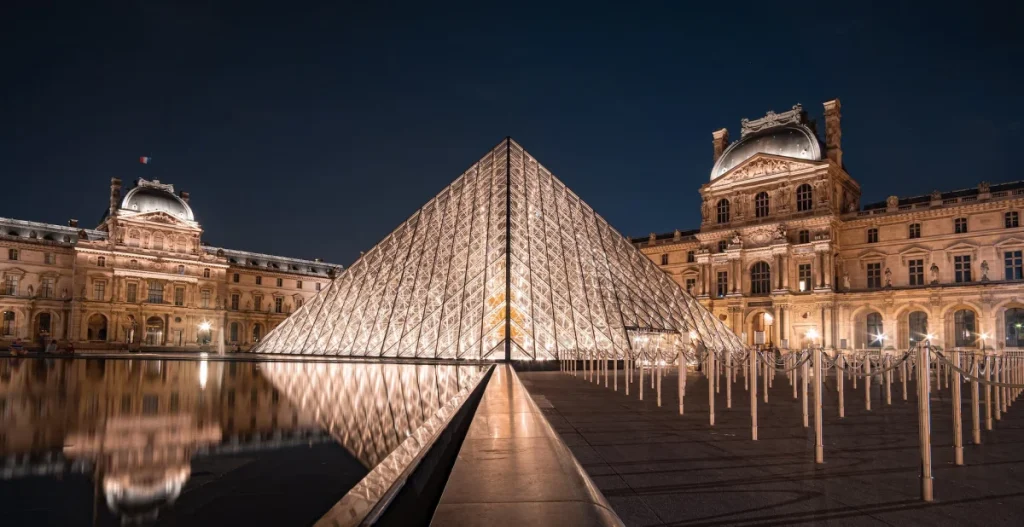This list of top Paris destinations ensures you won’t miss any of the city’s iconic attractions. Known as the “City of Love,” Paris beckons you to take romantic strolls along the Seine, explore neighborhoods like Montmartre and Le Marais, and admire landmarks like the Eiffel Tower, the Louvre, Sainte Chapelle, and the Notre Dame Cathedral. We hope the cathedral regains its former glory soon.
For your initial visit, plan around 4-5 days to fully savor essential Parisian experiences, such as enjoying coffee with a croissant on a charming terrace, picnicking with an Eiffel Tower view, and indulging in elegant shopping excursions. The city’s extensive metro system is the ideal way to get around, with Montmartre accessible by funicular or on foot. Our comprehensive guide features insights from our multiple visits to this enchanting city. Let the journey begin!
Top venues to visit in Paris
Paris is a city filled with iconic and culturally significant venues. While the “best” venues can vary depending on your interests, here are some of the most renowned and diverse places to visit in Paris.
-
- Eiffel Tower: The iconic symbol of Paris with breathtaking views.
- Louvre Museum: Home to masterpieces, including the Mona Lisa.
- Notre-Dame Cathedral: A masterpiece of French Gothic architecture.
- The Palace of Versailles: Explore the opulent former royal residence and gardens.
- The Musée d’Orsay: Showcasing Impressionist and Post-Impressionist art.
- Montmartre and Sacré-Cœur: A charming neighborhood and a stunning basilica.
- The Seine River: A romantic cruise with picturesque views.
- Champs-Élysées and Arc de Triomphe: Famous avenue and iconic arch.
- Palais Garnier: The exquisite Paris Opera House.
- Les Catacombes: Underground quarries filled with bones.
These venues offer a diverse and captivating experience of the rich culture and history of Paris.
Eiffel tower
The Eiffel Tower, constructed for the 1889 Universal Exhibition in Paris, didn’t initially win the favor of Parisians due to its unique design. However, it has since evolved into the most prominent symbol of Paris and the world’s most-visited monument, attracting over 7 million visitors annually.
To ascend to the tower’s highest point at 300 meters, an architectural marvel by Gustave Eiffel, we recommend taking the elevator rather than tackling the 1,665 steps. Keep in mind that elevator queues can be quite lengthy, but you can skip the lines by booking your entrance to the second or third floor in advance.
With the ticket, you gain access to all three tower levels, allowing you to appreciate the structure up close and relish spectacular panoramic views of the entire city. You can also savor a memorable meal at one of the best restaurants in Paris, “Madame Brasserie,” making it ideal for special occasions.
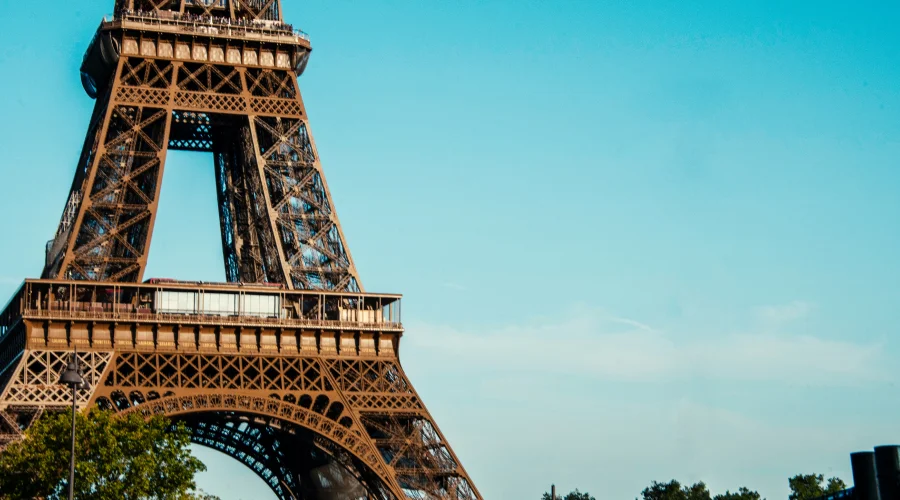
Louvre Museum
The Louvre, renowned as the world’s most famous and visited museum, is an absolute must-see in Paris. Inaugurated in the late 18th century within the grand Louvre Palace, this colossal space houses some of history’s most significant masterpieces. Among its treasures are Leonardo da Vinci’s “La Gioconda” (Mona Lisa), the “Venus de Milo,” and the ancient Egyptian “Seated Scribe.”
Adding to the museum’s allure is the iconic glass pyramid erected at its center in 1989, serving as the entrance. This pyramid is especially captivating when illuminated at night, leaving an indelible image in your memory.
To avoid the often lengthy entrance queues, which can exceed two hours. Another excellent way to bypass the lines and gain deeper insights into the history of the museum’s most important pieces is by booking a guided tour with an art and history expert.
If you’re not a fervent art enthusiast and wish to experience the Louvre efficiently, you can explore the museum in around 3 hours. A small map marking the most significant works across the three floors can guide your visit.
For those planning to visit multiple attractions in the city, the Paris Pass proves advantageous. It grants free access to over 60 points of interest in Paris, including the Louvre.
Notre-Dame Cathedral
The Cathedral of Notre Dame, constructed between 1163 and 1345, stands as one of the oldest and most magnificent Gothic cathedrals globally. Tragically, due to the devastating fire on April 15, 2019, the building suffered significant damage, and today, only its resplendent exterior remains, with a focus on the western facade and its striking twin towers. Above the doors of the facade, you can find 28 statues representing the kings of Judea and Israel.
While we all wait the hopeful and exact reconstruction of the cathedral as it stood before the fire, we can still cherish the memory of its radiant interior, characterized by its grand windows. Moreover, the ascent to its two towers offers an opportunity to encounter the renowned and enigmatic chimeras or gargoyles, from which you can savor unforgettable panoramic views of the city.
The Palace of Versailles
The Palace of Versailles is celebrated as one of the most renowned and iconic palaces globally, and it’s a highly sought-after destination for travelers in the City of Love. Declared a UNESCO World Heritage Site, this palace is renowned for its exceptional architecture, but it’s equally renowned for its expansive gardens spanning over 800 hectares, making a visit to Versailles a truly unforgettable experience.
Situated in the municipality of Versailles, approximately 25 kilometers from Paris, the Château de Versailles ranks among the most visited sites in the country. It is renowned for having served as the royal residence from 1682 to 1789.
The history of Versailles is rich and intriguing. It commenced when Louis XIII erected a hunting lodge on the grounds and continued with his son, Louis XIV, who oversaw numerous extensions and transformations. The site encompasses three palaces—Versailles, Grand Trianon, and Petit Trianon—along with several buildings added over the years, reflecting various reforms and expansions undertaken during its history.
A comprehensive visit to the Palace of Versailles is highly recommended, so it’s best to allocate at least a morning or afternoon to fully appreciate the site.
- Palace: While you’ll explore numerous rooms, some highlights include the Grand Apartments of the King and Queen, the illustrious Gallery of Mirrors, which spans 73 meters and boasts 375 mirrors, and the palace chapel.
- Gardens: The gardens are one of the primary attractions of the palace, featuring a multitude of fountains, meticulously designed gardens, and splendid sculptures. Particular points of interest include the Grand Trianon, a charming palace constructed from pink marble, and the Domaine de Marie Antoinette. The gardens can be explored on foot, by bicycle, or via an electric car, offering various ways to experience their beauty and grandeur.
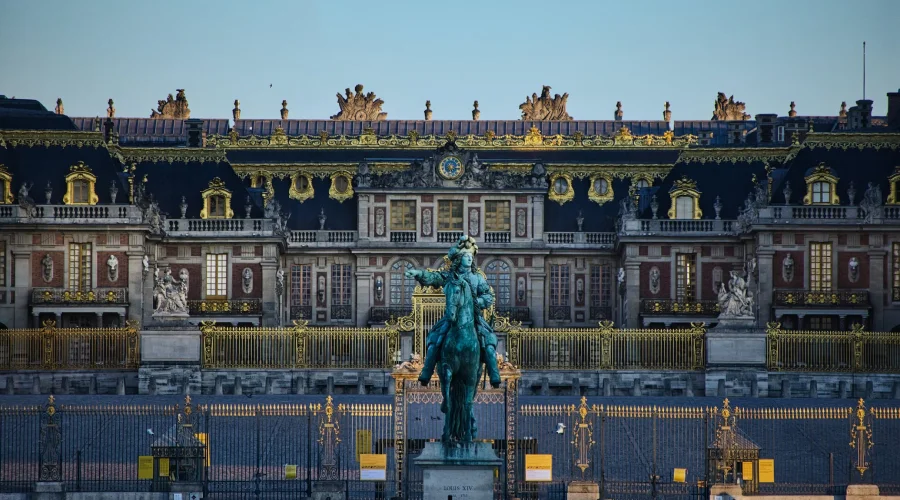
Musée d’Orsay
A visit to the Musée d’Orsay, situated in a former train station originally constructed for the 1900 Universal Exhibition, is another captivating experience that should not be missed in Paris.
Beyond appreciating the architectural beauty of this grand edifice, characterized by a massive glass and steel vault that bathes the interior in natural light and featuring the iconic station clock, the museum beckons visitors to immerse themselves in the remarkable works of art it houses. Some of the most celebrated masterpieces on display include “Luncheon on the Grass” by Manet, “The Starry Night” and various self-portraits by Van Gogh, “Women of Tahiti” by Gauguin, “Poppies” by Monet, and “The Card Players” by Paul Cézanne, among many others. The museum offers an enthralling journey through the world of art, highlighting works by some of the most celebrated painters in history.
Montmartre and Sacré-Cœur
Montmartre is one of our favorite neighborhoods in Paris, alongside Le Marais, and is a must-visit destination in the city. Despite its popularity among tourists, Montmartre has managed to retain a certain bohemian charm reminiscent of the past, when artists like Picasso and Van Gogh called it home. It’s the perfect place for leisurely strolls along its picturesque streets and buildings.
A visit to the Place du Tertre is a must, as it’s filled with artists creating and selling their paintings. Additionally, exploring the Basilica of the Sacré-Cœur, one of the most stunning sites in Paris, is an unforgettable experience. This church, built between 1875 and 1914, is known for its white facade, blending Roman and Byzantine architectural styles, and its grand staircase, which offers one of the most exceptional sunset views in Paris.
One aspect of Montmartre that may not be highly recommended, at least in our experience, is dining in the area. Most restaurants tend to offer tourist menus with a relatively modest quality-to-price ratio, making it less appealing for lunch or dinner. However, the neighborhood’s overall ambiance and attractions more than make up for this culinary limitation.
Seine River
The Seine River, which meanders through Paris and gives rise to picturesque islands like the Île de la Cité and the Île Saint-Louis, has become one of the city’s most alluring attractions. A delightful way to experience it is by taking a leisurely stroll during sunset from the Notre Dame Cathedral to the Eiffel Tower along the riverbanks, offering one of the most romantic promenades in the world.
As you journey along the Seine, you’ll traverse some of the city’s most splendid bridges, including the New Bridge, the Bridge of Souls, the Pont Alexandre III, and the Pont des Arts, which provides beautiful views of the Île de la Cité. However, our personal favorite is Le Pont Neuf, constructed in the late sixteenth century, and it holds the distinction of being the oldest bridge in Paris, linking the Île de la Cité with the rest of the city.
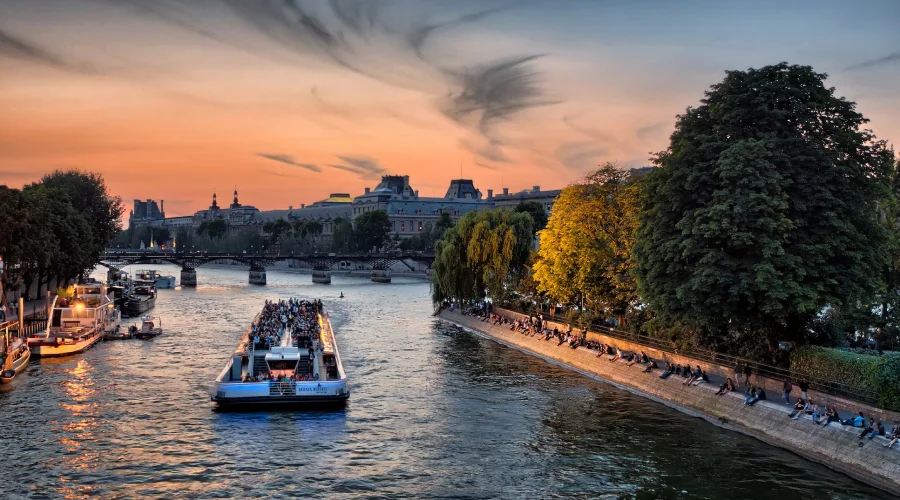
Champs-Élysées and Arc de Triomphe
The Champs-Élysées is a broad, two-kilometer-long avenue that links the Place de la Concorde with the Arc de Triomphe, and is one of the most renowned destinations to explore in Paris. It’s a boulevard lined with a multitude of luxury retail stores, international dining establishments, and stately historic buildings such as the Petit and Grand Palais.
As you conclude your stroll along the avenue, you’ll arrive at the Place de la Concorde, a location that holds a dark historical significance from the French Revolution when more than 1,000 individuals were executed by guillotine. Today, you can see an ancient Egyptian obelisk that is over 3,000 years old gracing the square. The Champs-Élysées and the Place de la Concorde offer a blend of high-end shopping, captivating history, and notable landmarks in the heart of the city.
The Arc de Triomphe, constructed between 1806 and 1836 by Napoleon to commemorate his monumental victory in the Battle of Austerlitz, stands as one of the most iconic landmarks in the world and is a must-see in Paris. It measures 50 meters in height and 45 meters in width and draws inspiration from the Arch of Titus in Rome. The Arc de Triomphe is situated in one of the world’s largest traffic circles, necessitating access through an underpass to reach it. Once in front of the monument, you can witness the solemn Tomb of the Unknown Soldier from World War I.
In addition to being a symbol of both Paris and France as a whole, the Arc de Triomphe offers one of the finest vantage points in the city, providing excellent views of the grand Champs-Élysées avenue. Entrance to the monument is free with the Paris Pass, or you can book a skip-the-line ticket in advance for added convenience.
Palais Garnier
The Opera Garnier, an immense edifice constructed in the neo-baroque style during the 19th century by Napoleon’s order, is another one of the most enchanting sights to behold in Paris. Its lavishly adorned interior presents a sumptuous and opulent spectacle, featuring gilded elements, intricate mosaics, and grand chandeliers. Among its standout features are the grand marble staircase and the magnificent auditorium, bedecked in red and gold, which famously inspired the novel “The Phantom of the Opera.” This landmark is a testament to the city’s cultural and architectural grandeur.
Arguably one of the most exquisite structures in Paris and certainly one of the city’s most significant landmarks, the Palais Garnier, also known as the Opera Garnier, is a must-visit on any trip to the French capital. Commissioned by Napoleon III, this architectural marvel was designed by Charles Garnier in the Second Empire Style, also known as Napoleon III Style. The building was inaugurated in 1875 under the name of the National Academy of Music-Paris Opera House. In 1978, the opera company relocated to the Bastille Theater, and the edifice became known as the Palais Garnier. Nevertheless, it’s still commonly referred to as the Opera Garnier or the Paris Opera, as it continues to host concerts, plays, and operas, making it a hub of cultural excellence.
Les Catacombes
The Catacombs are another intriguing and increasingly popular attraction to explore in Paris. This vast underground network of tunnels and subterranean chambers, located 20 meters beneath the surface, houses the remains of over 6 million skeletons from various historical periods, arranged in a massive ossuary. It’s essential to note that while the network comprises approximately 300 kilometers of tunnels, only 800 meters of bone-lined wall galleries are accessible to the public.
To avoid the often lengthy queues, which can extend to more than 3 hours, it’s advisable to secure your entrance ticket in advance. The Catacombs are somewhat distant from the city center, so a convenient way to reach them is by taking the metro lines 4 and 6 to the Denfert-Rochereau station.

Other places to visit in Paris
Place du Trocadéro
Arriving early in the morning at Trocadero Square, whether by metro, bus, or on foot, is a top Parisian experience for an unobstructed view of the Eiffel Tower. This iconic view is one of the city’s highlights.
Arriving early allows you to leisurely stroll through the Trocadero Gardens, a delightful ensemble of green spaces, ponds, and ornate sculptures, such as the famous “Bull and Fallow Deer.” These gardens extend from the Chaillot Palace, gently descending to the Jena Bridge over the Seine River.
At the garden’s end, you’ll encounter a picturesque carousel and the serene Seine River banks, offering another excellent vantage point to admire the Eiffel Tower.
For additional breathtaking views of the Eiffel Tower, we recommend exploring nearby locations such as Rue de l’Université and the Champ de Mars. These areas are perfect for a leisurely picnic, providing unforgettable perspectives of the iconic landmark.
Luxembourg Gardens
Nestled in the heart of Paris, the Luxembourg Gardens, or Jardin du Luxembourg, is a serene and picturesque haven that offers respite from the hustle and bustle of the city. These beautifully manicured gardens, spanning 23 hectares, have a rich history and offer a delightful blend of natural beauty, art, and culture.
The Luxembourg Gardens were created in the early 17th century at the behest of Queen Marie de’ Medici, who designed them to resemble the Boboli Gardens in Florence, Italy. Today, they are a beloved destination for Parisians and tourists alike, providing a peaceful escape in the midst of a lively metropolis.
One of the most iconic features of the Luxembourg Gardens is the Grand Bassin, a large octagonal pond where visitors can rent small sailboats and watch them gracefully glide across the water. The pond is bordered by the striking Luxembourg Palace, which now houses the French Senate. The palace’s beautiful façade and immaculate gardens are a testament to the grandeur of French architecture and design.
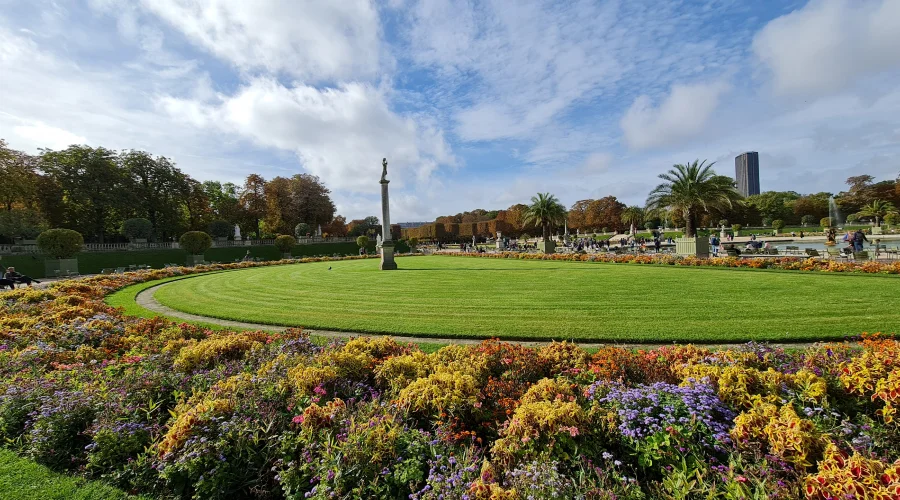
National Library
Visiting the Richelieu-Louvois branch of the National Library of France, nestled between the streets des Petits-Champs, Vivienne, Louvois, and Richelieu, is one of the finest free activities in Paris. While without a library card, your access will be limited to certain areas, you can still explore the magnificent reading room. This reading room boasts a stunning design, with nine domes supported by iron arches, bathing the space in natural light.
Another remarkable library to explore in Paris is the Mazarin Library, situated along the Quai de Conti on the banks of the Seine. It holds the distinction of being the oldest public library in France, making it a captivating stop for history and literature enthusiasts. Both of these libraries offer a unique perspective on Paris’s intellectual and architectural heritage.
Sainte Chapelle
Sainte Chapelle is a favorite church in Paris and is often regarded as one of the most beautiful in the world. This Gothic marvel is located on the enchanting Île de la Cité and was constructed between 1241 and 1248 to house several precious relics, including the crown of thorns, a portion of the cross, the iron of the spear, and the sponge used during the martyrdom of Jesus Christ. What distinguishes the interior of Sainte Chapelle is its remarkable lack of walls, emphasizing the breathtaking stained glass windows in the upper chapel. The sheer beauty of these windows will leave you in awe.
The lower chapel, in contrast, features a more austere ambiance and houses a 13th-century fresco of the Annunciation, considered the oldest mural in the city.
To enrich your understanding of this church’s history and ensure you don’t miss any intricate details, consider booking a guided tour with an expert guide, which often includes a tour of the island as well. If you prefer to explore independently, you can book your skip-the-line ticket in advance. Additionally, you might be interested in a combined ticket that includes the Conciergerie, a former Gothic palace turned prison. The Conciergerie held historical figures like Marie Antoinette, and you can visit her cell.
A visit to Sainte-Chapelle in Paris is an essential experience for many travelers who wish to immerse themselves in the enchantment of one of the world’s most romantic cities. Celebrated as one of the pinnacle achievements of Gothic architecture, this chapel was constructed to house the relics acquired by King Louis IX, including the revered crown of thorns, a prominent Christian symbol associated with the Passion of Christ.
What truly sets Sainte-Chapelle apart are its 15 polychrome stained glass windows, each spanning 15 meters in height. These stunning windows have become iconic symbols of the city and are sure to leave a lasting impression, evoking a sense of awe and wonder in all who behold them.
Gallery Vivienne
Exploring the traditional shopping arcades in Paris is a quintessential experience, offering a delightful blend of fashion and antique stores. These arcades provide a perfect backdrop for enjoying a coffee with a croissant in one of their charming cafes or pastry shops, making it one of the best activities in Paris.
Among our personal favorites are the Passage des Panoramas and the Vivienne Gallery. Both of these enchanting galleries feature similar architectural designs from the early 19th century, prioritizing the passage of natural light and showcasing quintessential Parisian aesthetics. Strolling through these arcades will transport you to a bygone era of opulence and elegance, allowing you to relish the rich history and culture of the city.
Place Vendome
Place Vendôme is undoubtedly one of the most exquisite squares to explore in Paris. Its focal point, the grand Vendôme Column, was commissioned by Napoleon in 1810, drawing inspiration from the Trajan Column in Rome. The square is encircled by historic buildings, some of which are home to the most opulent hotels in Paris, including the renowned Ritz and Vendôme. You’ll also discover upscale fashion boutiques like Dior and Chanel, as well as prestigious high-end jewelry and watchmaking shops, exemplified by Cartier.

Torre Montparnasse
The Montparnasse Tower, soaring to a height of 210 meters, is our preferred viewpoint for taking in the sights of Paris. This modern office building, which stands in contrast to the city’s classical architecture, features an observation deck on the 56th floor and a remarkable outdoor terrace on the 59th floor, equipped with protective glass but offering open-air spaces for capturing stunning 360-degree panoramic views of Paris. The Eiffel Tower takes center stage in the panorama. While it’s located a bit away from the city center, it’s easily accessible by metro, with lines 4, 6, 12, and 13 stopping at Montparnasse-Bienvenüe. It’s advisable to book your entrance in advance, especially on weekends and during high tourist seasons, as there’s a limited daily capacity.
Le Marais
Taking a leisurely walk through the bohemian neighborhood of Le Marais, nestled in the heart of Paris along the Seine, is another top activity to enjoy in the city. This area allows you to immerse yourself in old Paris as you wander along its charming cobblestone streets, replete with vintage shops, hidden courtyards, art galleries, fashion boutiques, grand mansions, designer eateries, and perfect picnic spots like the splendid Place des Vosges. This square, the oldest in the city, is home to Victor Hugo’s former residence and the delightful courtyard of the Hôtel de Sully.
The neighborhood’s most renowned streets, bustling with locals, include Rue de Rivoli, Rosiers, Charlot, des Archives, Bourg Tibourg, Vieille du Temple, Oberkampf, and Rue des Francs-Bourgeois, along with the numerous adjacent alleys. Le Marais also boasts some of the finest dining establishments in Paris, such as L’As du Fallafel, Benedict, Comptoir Gourmet, and Pain Vin Fromage, known for its delectable fondue.
Les Halles
Starting your journey from the Saint Jacques Tower, you can embark on a delightful tour through the Les Halles neighborhood, centered around the iconic Pompidou Center, which is another of our favorite destinations in Paris. This vibrant neighborhood, adjacent to Le Marais, offers a multicultural experience as you explore its diverse streets and historical landmarks, including the Bourse (Stock Exchange), Nelson Mandela Garden, and the Church of St. Eustache.
One of our cherished spots in this area is Rue Montorgueil, a bustling street brimming with shops and inviting terraces for enjoying a refreshing drink. Don’t miss the opportunity to dine at Au Pied de Cochon, a renowned restaurant offering a variety of classic French dishes like onion soup, foie gras, and escargots (snails).
To conclude your exploration, head to the whimsical Stravinsky Fountain, and be sure to visit the Georges Pompidou National Center of Art and Culture. This institution is famous for its avant-garde exterior design featuring colorful tubes along the façade, and it houses a priceless collection of modern art, featuring works by illustrious artists like Picasso, Kandinsky, Matisse, and Miró.
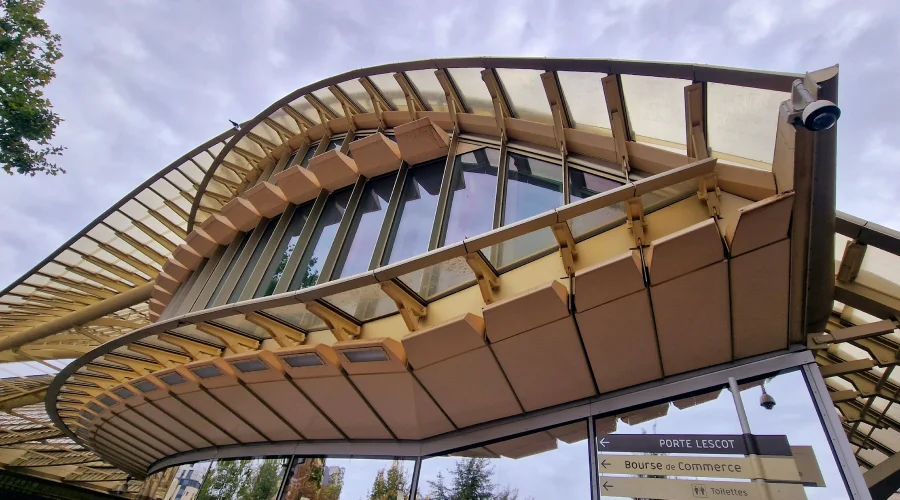
In conclusion, Paris is a city that lives up to its reputation as one of the most enchanting and captivating destinations in the world. With a rich tapestry of history, culture, and art, it offers travelers an array of iconic landmarks, charming neighborhoods, and exquisite experiences. From the romantic ambiance of Montmartre to the architectural splendor of the Eiffel Tower, the Louvre’s artistic treasures, and the vibrant life along the Seine, Paris provides an abundance of delights for all types of visitors.
While it’s challenging to narrow down the best places to visit in Paris due to the city’s sheer diversity, our list highlights some of the most iconic and cherished locations that are essential for anyone’s Parisian adventure. The City of Love and Light welcomes you with open arms, promising a journey filled with unforgettable moments, delectable cuisine, and awe-inspiring beauty.
Each corner of Paris reveals a piece of its history, from the grandeur of Versailles to the tranquility of Luxembourg Gardens. Paris doesn’t just offer sights and sounds; it provides sensations and experiences that linger in your memory. So, whether you’re wandering along the Seine’s riverbanks, ascending the Eiffel Tower, or savoring a croissant in a charming cafe, you’ll find that Paris weaves its enchanting spell around you. This city invites exploration, reflection, and romance, ensuring that every visit is a treasured voyage into the heart of art, history, and culture. In Paris, the world truly becomes a stage, and you, the fortunate traveler, are the star

